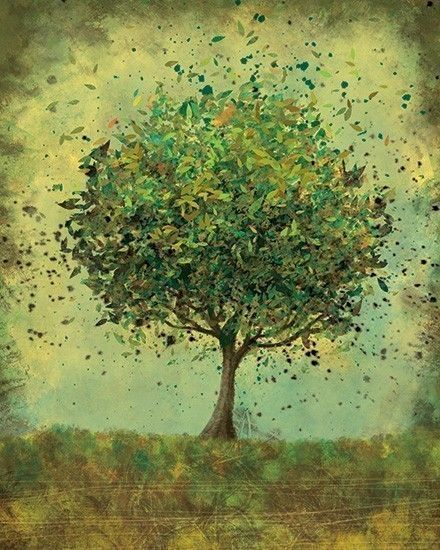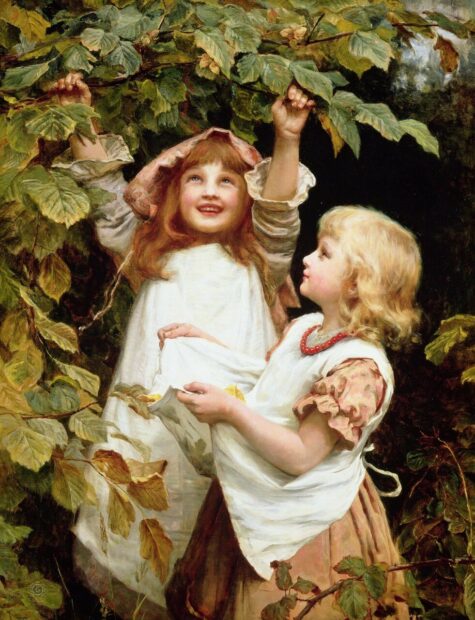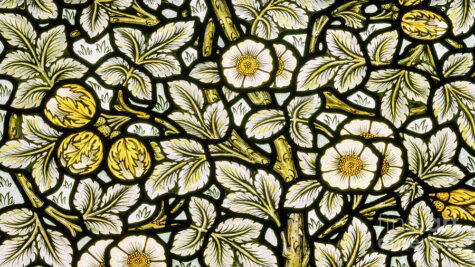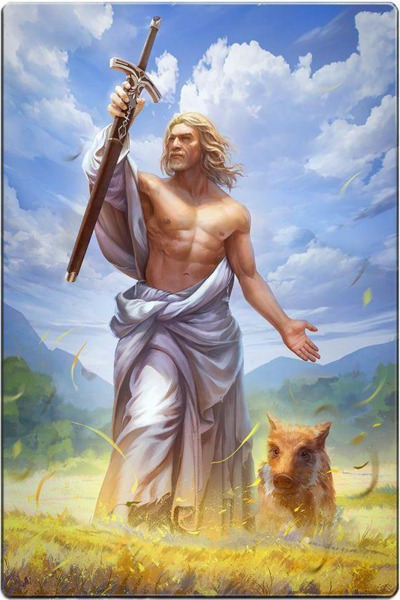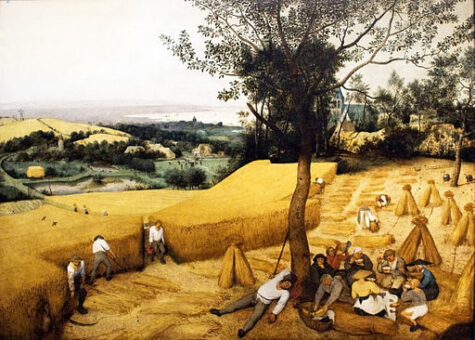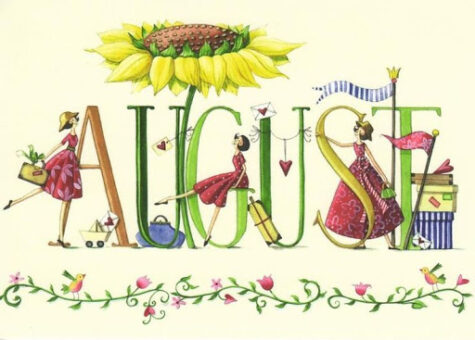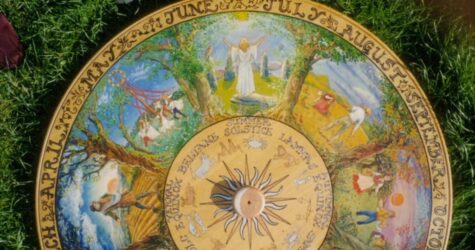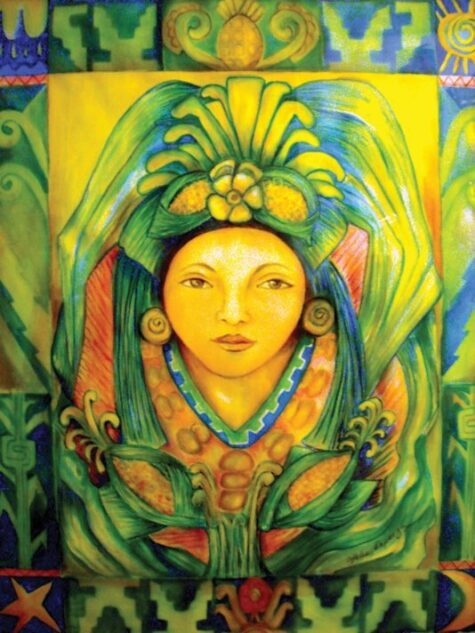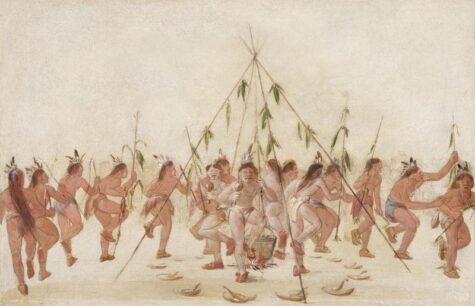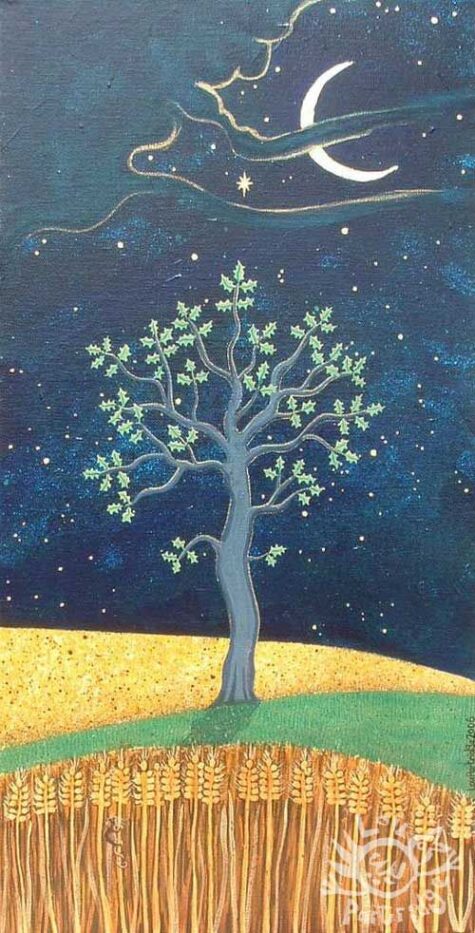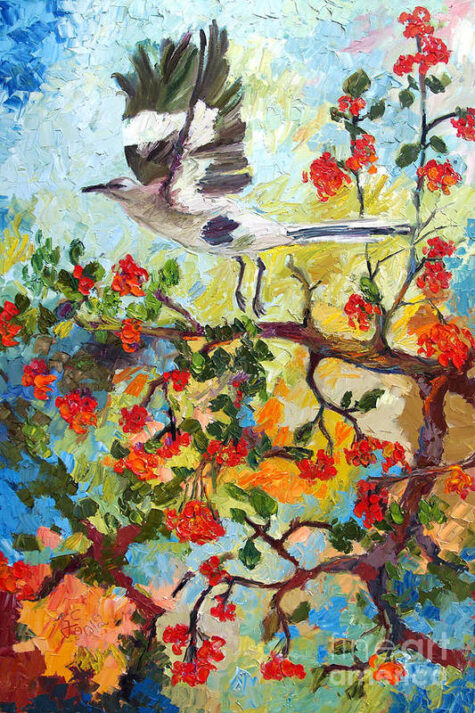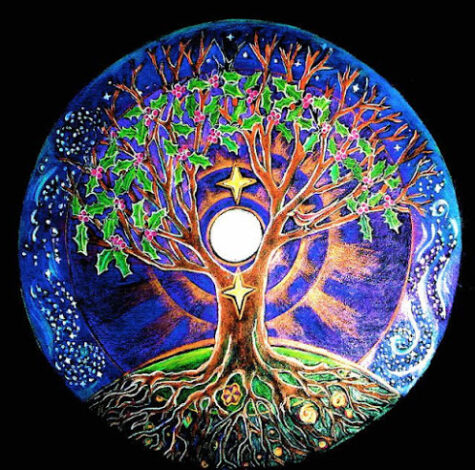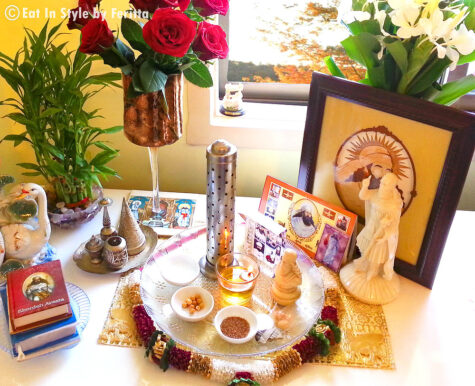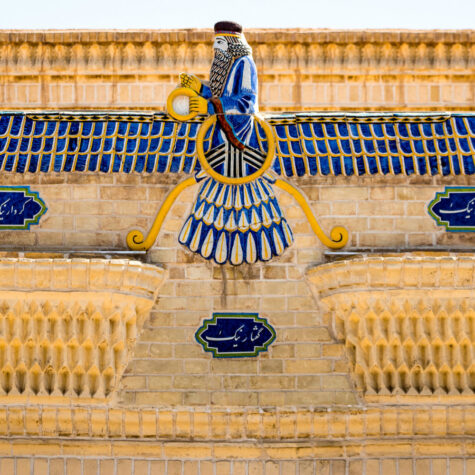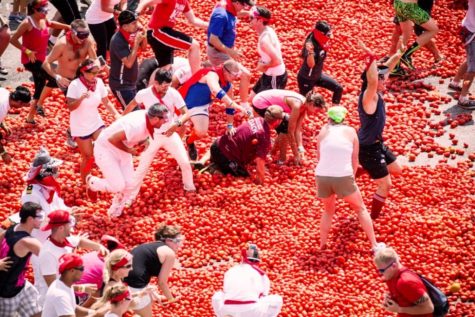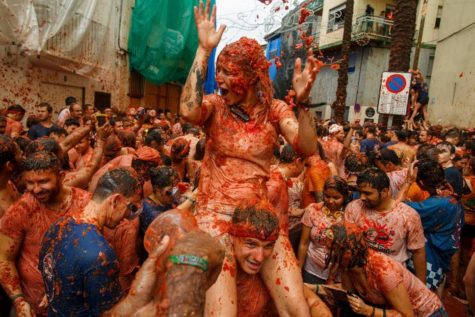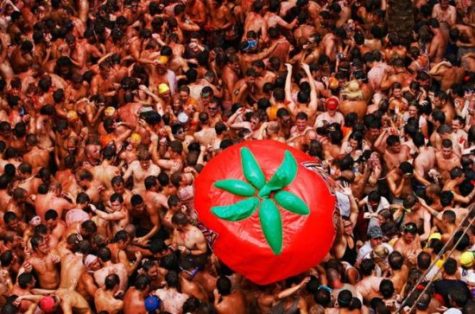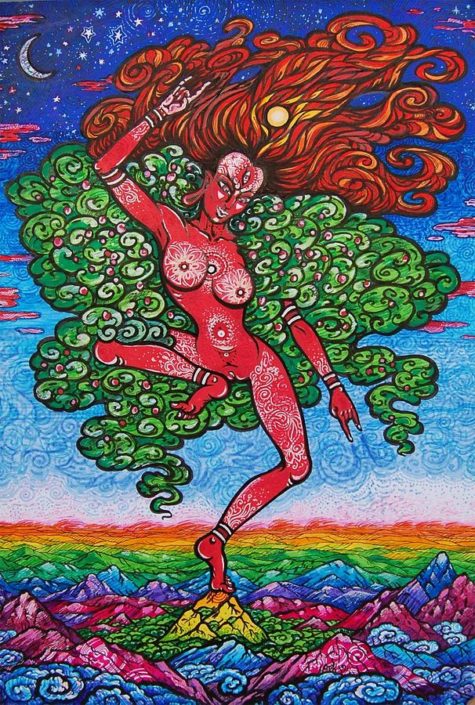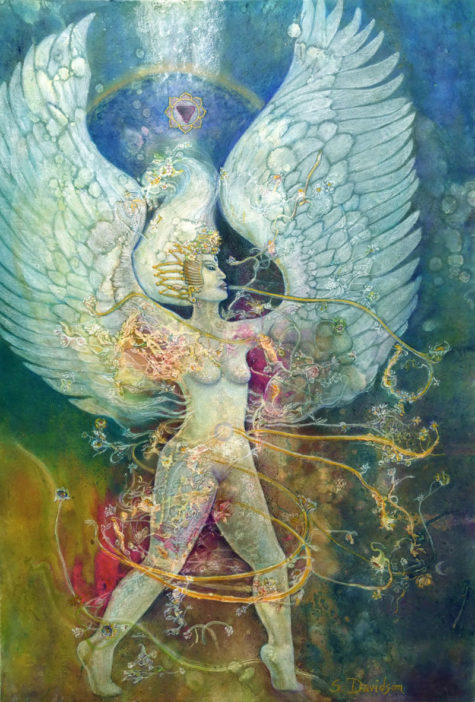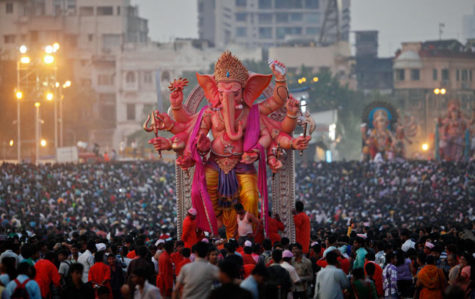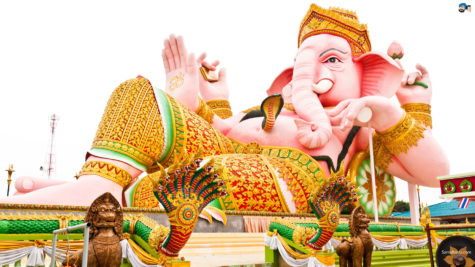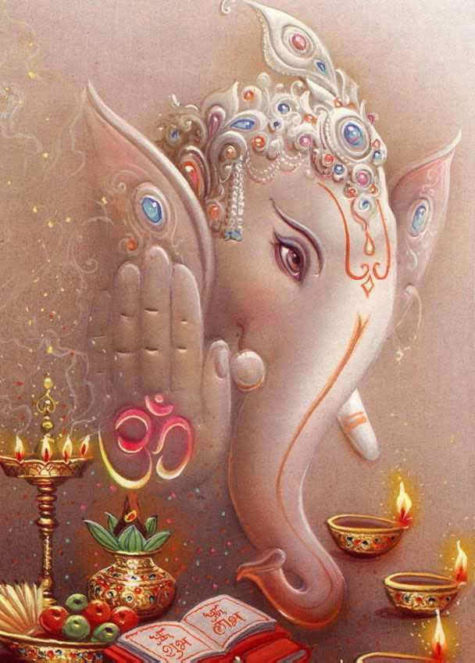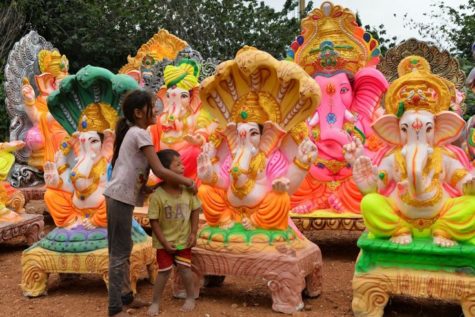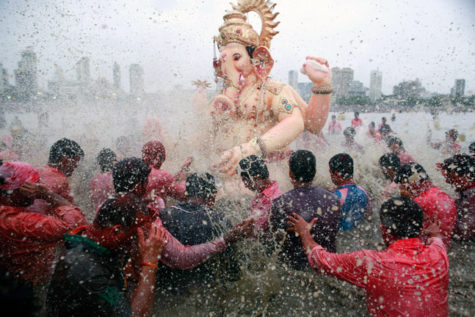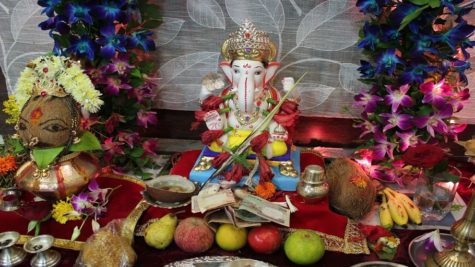August
The festival of Nemoralia (aka Festival of Torches) was celebrated by the ancient Romans either on 13–15 August or on the August Full Moon, in honor of the goddess Diana (Diana Nemorensis). This festival was later adopted by Catholics as The Feast of the Assumption.
Ovid describes the celebration thus:
“In the Arrician valley, there is a lake surrounded by shady forests, Held sacred by a religion from the olden times… On a long fence hang many pieces of woven thread, and many tablets are placed there as grateful gifts to the Goddess. Often does a woman whose prayers Diana answered, With a wreath of flowers crowning her head, Walk from Rome carrying a burning torch… There a stream flows down gurgling from its rocky bed…”
On this day, worshippers would form a shimmering procession of torches and candles around the dark waters of Lake Nemi, Diana’s Mirror. The lights of their candles join the light of the moon, dancing in reflection upon the surface of the water. Today’s festival is held in the Greek fashion.
Hundreds join together at the lake, wearing wreaths of flowers. According to Plutarch, part of the ritual (before the procession around the lake) is the washing of hair and dressing it with flowers. It is a day of rest for women and slaves. Hounds are also honored and dressed with blossoms. Travelers between the north and south banks of the lake are carried in small boats lit by lanterns. Similar lamps were used by Vestal virgins and have been found with images of the Goddess at Nemi.
One 1st century CE Roman poet, Propertius, did not attend the festival, but observed it from the periphery as indicated in these words to his beloved:
“Ah, if you would only walk here in your leisure hours. But we cannot meet today, When I see you hurrying in excitement with a burning torch To the grove of Nemi where you Bear light in honour of the Goddess Diana.”
To Do Today
Requests and offerings to Diana may include: small written messages on ribbons, tied to the altar or to trees; small baked clay or bread statuettes of body parts in need of healing; small clay images of mother and child; tiny sculptures of stags; dance and song; and fruit such as apples.
In addition, offerings of garlic are made to the Goddess of the Dark Moon, Hecate, during the festival. Hunting or killing of any beast is forbidden on Nemoralia.
Source: Wikipedia
The Hazel Month offers you an opportunity to connect with your inner reserves of wisdom. Now is the time to listen to your intuition. Study of all kinds is blessed during the Hazel Month, so energy that uses ancient knowledge is most effective now.
This is also an excellent time to learn to read Tarot Cards or Runes because lunar energy will enhance your memory and psychic powers. Maintain an optimistic approach and follow your enthusiasm.
- Dates: August 5 – September 1
- Celtic Name: Coll
- Language of Flowers: Reconciliation
Qualities: Wisdom, knowledge, protection, love, healing, understanding, inspiration, divination - Themes: Life Force, Wisdom, Protection, Knowledge, The Creative Muse.
Hazel, known to the Celts as Coll, translates to “the life force inside you,” is the time of year when Hazelnuts are appearing on the trees, and are an early part of the harvest. This is the month of wisdom and protection and magick concerning these areas are best done at this time.
This is a good month to do workings related to wisdom and knowledge, dowsing and divination, and dream journeys. If you’re a creative type, such as an artist, writer, or musician, this is a good month to get your muse back, and find inspiration for your talents. Even if you normally don’t do so, write a poem or song this month.
Bring the creativity and inspiration of the Hazel into your life both at work and at home. Use this time to inspire your inner creativity and wisdom or to ground yourself in nature.
- Enroll in an evening class. Now is an auspicious time to learn a new skill – try a painting class, learn a language or dance.
- Keep a journal. Just writing down your wishes and experiences will help you tune into your inner wisdom.
- Go outside at night and look at the Moon. Staying connected to nature will bring powerful insights and help you remain grounded.
- Feed your mind. Buy a book of inspiring quotes and read one each day to stimulate and sharpen your thinking.
- Eat a feast of salmon and hazelnuts before an exam to heighten your powers of concentration and boost your memory.
Hazel the Knower
When a person is born under the energy of the Hazel, he or she becomes highly intelligent, organized and excels in the classroom. Just like the Holly, this Celtic tree sign is naturally gifted when it comes to knowledge. They possess the ability to recite and recall information, which makes them appear as know-it-all to others. However, you can’t blame the Hazel for being naturally smart.
They are quiet, discreet, they never draw attention on them, they do not raise their voice and very often you do not notice when they are around. Nevertheless, the saying “Still waters run deep” describes them well. Hazel people are usually very intelligent, they have great memory, good intuition and the ability to learn quickly. They come across as plain but potent people. Exactly this type of people used to be considered a saint or blamed for witchcraft a few centuries ago.
Hazel people usually achieve their goals easily because they are able to take advantage of all their abilities. In relation to others, they tend to be friendly, helpful and easy-going. They can be very patient, understanding and selfless, and they are very generous to their friends. They always start everything with love and goodness because they believe that is the easiest way to achieve things.
Thanks to their foresight and high intelligence they often come up with unusual ideas and solutions that they have thought through to the smallest details. This clever sign from the Celtic tree horoscope pairs well with the Hawthorn and Rowan signs.
Hazel Magick and Lore
The Hazel tree is known as the Tree of Immortal Wisdom or the Tree of Wisdom and Learning. Hazel branches have been used over history for divining due to their pliancy and affinity for water. The Hazel tree encourages us to seek out wisdom, information, and inspiration in all things both living and inorganic.
In the south-west of England, the Hazel was said to be surrounded by silver snakes around its roots, giving the tree its special life force – an ability to understand all, swiftly, and to understand all connections.
A forked Hazel branch was often used by dowsers – representing the forked tongue of the snake, or perhaps the dual aspect of life and death, which the Hazel also symbolizes.
Hazel branches should only be cut with the tree’s permission – and Hazel rods cut on Midsummer’s Eve are the most powerful. Draw a circle around your bed with a Hazel stick to keep nightmares away. Dreaming about a Hazel tree indicates wealth and unexpected good fortune in the future.
“Wishing wands” (seen in Teutonic myths) were cut from Hazel. It was said that to cut a Hazel wand, you should find a tree that’s not yet fruited, and using a ‘magical sickle’, cut a branch in a single stroke, at sunrise on a ‘day ruled by Mercury’ (a Wednesday).
The Hazel is the Celtic Tree of Knowledge, the Poet’s Tree, a magical tree, and tree of fairies. It’s a tree of wisdom, of understanding and connection, and a tree of clear communications. It’s a tree of life and death, bridging the worlds and enabling connection and communication between the worlds – a tree of health, healing, and protection – and a tree of love!
In Ancient Rome, Hazel torches were lit on the wedding night to ensure a happy marriage. And in Devon, brides would be met from church by an old lady carrying a basket of hazelnuts, for luck.
A sprig of Hazel by the door of a home, or on a windowsill or by a window-opening, was supposed to be able to protect against lightning – and Hazel twigs gathered on Palm Sunday were thought to guard against both lightning and fire.
Hazel Energy Meditation
Practicing this meditation will help you to move through creative blocks, open to inner guidance and develop your intuition.
- Approach a Hazel tree from the north.
- When you are within the circumference of its branches, introduce yourself and ask permission to come closer.
- If it feels right to proceed, circle the trunk clockwise.
- Try to sense the spirit of the tree and open your heart.
- Sit with your back against the trunk and breathe deeply.
- Empty your mind and attune to the tree’s energy.
Sources:
Freyfaxi, Freysblöt, or Hlæfæst (which means Loaf Feast) which celebrates the beginning of the harvest. There is no specific “correct” date for this harvest festival; some groups celebrate it at the beginning of the month (to coincide with Lammas), some mid-month, and some on the full moon.
Freyr is the Norse god of fertility and harvest and a blöt is a sacrifice or offering to a god. So Freysblöt is offerings to Freyr, this is done in celebration of the beginning of harvest. The feast is also thought of as holy to Thor as a harvest God and his wife Sif, whose long golden hair can be seen in fields of ripe grain.
The first sheaf of harvested grain was bound and blessed for the gods and the vaettir (land or place spirits). Bread baked from the first harvest was also made into an offering and shared with the community.
In Viking times this is also when the warriors who had gone off to fight at the end of planting season came back, loaded with a summer’s worth of plunder and ready to reap the crops that had ripened while they were gone. It is almost like American thanksgiving, feasting and celebrating the first fruits and grains from harvest.
In modern times this is often just before back-to-school giving families and kindreds a good opportunity to celebrate together before the added stresses of homework and extracurricular activities. While the celebrations were modest compared to some of the other major holidays it was still an excellent reason to gather in celebration and to recognize the prosperity in our lives.
Since it draws from First Harvest traditions, the dates would vary regionally, but falls sometime in the beginning of August, because that is when many of our gardens are coming into full production. Typically in the northern hemisphere it is around this time that we celebrate the bounty of the Earth, and the gifts that she brings us with the help of Frey.
In truth, “Freyfaxi” is basically made up and can be celebrated by any group that wants to when they want to. It isn’t wholly without reference, as it draws on a history of First Harvest traditions, but it isn’t historical by any means. Wikipedia pins it on August 1st, the Ásatrú Alliance’s holidays page dates it as August 19th, and many Pagan Calendars date it to August 23rd.
Loaf-Feast is the end of the summer’s vacation, the beginning of a time of hard work which lasts through the next two or three months, while we ready ourselves for the winter.
The holiday of FreyFaxi was much more important for the lives of our ancestors that it is today. Without a good harvest, many many people would perish in the winter. We honor Frey to thank him for the many harvests that we have had, if there was one terrible one, some of us may not be here today. Thanks to Frey we are. If a year was particularly horrible, drastic sacrifice would be used – animal, or even human in some cases.
Even though many of us are no longer farmers, we still depend on the land for all that we are given. Maybe we do not depend on it directly but most of us go to the grocery store and buy things that have come from the fields. This is a time to honor Frey, god of the harvest, rains, and fertility. A time to thank him for the bounty of the earth, and all the gifts that he bestows upon us.
Today we honor him with mead, or some type of drink, food from our table, typically foods we harvest ourselves, for example baked bread that we have made ourselves from the wheat he has bestowed upon us. It is traditional to mark the holiday by baking a figure of the God Freyr in bread, and then symbolically sacrificing and eating it. Any way that you honor Frey, is a good way. Traditionally however, it is with a blot and feast.
We honor him because without him, simply we would not have much of our food supply, and quite obviously without that, we do not have much at all! He bestows fertility to the fields and plants, gives them life, giving rain so that they may grow and flourish. These plants including trees, give us oxygen. So if you are not going to honor Frey, son of Njord, for the bounty of the land at least honor him for the life of the plants and world around us!
We honor Frey by giving him a blot, and a grand feast from our own gardens and the fields. (If you do not have these things at least go spend some money and get a few things from a farmers market or something similar). We thank Frey, and honor him for the harvest and the fertility of the land and ask him to give the land even greater fertility in the coming year and in the dark of winter.
Sources:
There is a lot to celebrate in August. This is a list of pretty much everything that goes on during the eighth month of the year. Many of these dates change from year to year. The days that change are marked with this » symbol.
August Lore and General Info

Astronomical Events
- August 8 » New Moon
- July 3 thru August 11: Dog Days of Summer
- August 22 » Full Moon – Corn Moon, Blue Moon
- July 12 thru August 23: Delta Aquarids Meteor Shower
- July 17 thru August 24: Perseids Meteor Shower
Astrological Events
Depending on which astrological system you adhere to, these are the signs that show up in August of 2021. Be aware that some of these dates will vary from year to year. Unlike the Sun signs which might just shift by 1 or 2 days, the dates of the various Moon signs will vary widely from year to year. The same holds true for the Chinese Zodiac. The Celtic Tree Signs are based on an arbitrary system and stay the same from year to year.
The August Sun begins in Leo and finishes up in Virgo:
- Jul 22 thru Aug 22 » Sun in Leo
- Aug 22 thru Sep 22 » Sun in Virgo
The moon cycles through the signs as follows:
- Jul 30 – Aug 2 » Moon in Taurus
- Aug 2 – Aug 4 » Moon in Gemini
- Aug 4 – Aug 7 » Moon in Cancer
- Aug 7 – Aug 9 » Moon in Leo
- Aug 9 – Aug 11 » Moon in Virgo
- Aug 11 – Aug 14 » Moon in Libra
- Aug 14 – Aug 16 » Moon in Scorpio
- Aug 16 – Aug 18 » Moon in Sagittarius
- Aug 18 – Aug 20 » Moon in Capricorn
- Aug 20 – Aug 22 » Moon in Aquarius
- Aug 22 – Aug 24 » Moon in Pisces
- Aug 24 – Aug 27 » Moon in Aries
- Aug 27 – Aug 27 » Moon in Taurus
- Aug 29 – Sep 1 » Moon in Gemini
You will notice that the Moon might begin the day in one sign and by the end of the day may have moved into another sign, so timing matters if you are wanting to be precise.
The Celtic Tree Signs in August:
- Jul 8 – Aug 4: Month of the Holly Tree
- Aug 5 – Sep 1: Month of the Hazel Tree
The Alternative Celtic Zodiac is as follows:
- Cypress: Jul 25 – Aug 4
- Poplar: Aug 5 – Aug 14
- Larch: Aug 15 – Aug 24
- Pine: Aug 25 – Sep 3
The Chinese Calendar and Zodiac
We are currently in the year of the Ox (sometimes referred to as the Cow). Each Month is also assigned a specific animal. Here’s what shows up in August 2021.
- Sheep: Jul 7 – Aug 6 (Chinese Zodiac – Stem Branch Calendar)
- Sheep: Jul 10 – Aug 7 (Lunar Calendar – 6th Month)
- Monkey: Aug 7 – Sep 6 (Chinese Zodiac – Stem Branch Calendar)
- Monkey: Aug 8 – Sep 6 (Lunar Calendar – 7th Month)
Note: The traditional Chinese Astrology birth chart is built by the Chinese Stem Branch Calendar, not the Chinese Lunar Calendar, which I think is really confusing. Because of a difference in time zones, the lunar months will have different pattern between China and the USA.
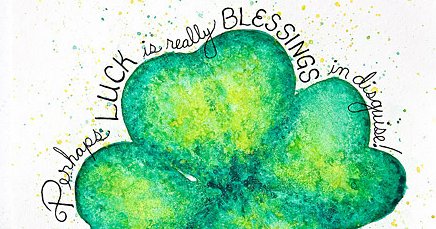
Lucky and Unlucky Days
You might want to plan moving, traveling, major purchases, court dates, and weddings around these dates, avoiding the unlucky days and utilizing the lucky ones.
- These are the lucky days in August:
6, 7, 10, 11, 19 and 25. - These are the unlucky days in August:
15, 20 and 21.
Fatal Days
The first kills strong ones at a blow.
The second lays a cohort low.
Holidays and Holy Days
Many of the holidays begin on the eve of the night before and end on the eve of the day of. It’s also important to remember that the dates of archaic festivals and feast days may vary widely depending on the source.
August 1
- 1: Lammas or Lughnasadh
- 1: Festival of Lugh – the Celtic hero god.
- 1: Imbolc (Southern Hemisphere)
- 1 » Blessing of the Sea – first Sunday in August
- 1: Freyfaxi – dates vary widely from place to place
- 1: Wipe The Slate Clean Day
- 1: Fast in Honor of Holy Mother of Jesus
- 1: Wipe The Slate Clean Day
August 3
- 3 » Dakini Day (Tibetan)
August 4
- 4 » Day of Ekadashi (Hindu)
August 6
- 6: Festival of Thoth
- 6: Feast of the Transfiguration
- 6 thru 15 : Festival of the Tooth
August 7
August 8
- 8 thru Sept 7 » Ghost Month
August 9
- 9: Festival of Sol Indigis – the Roman sun god
- 9 » The Noumenia
August 10
- 10 » Celebrating The Agathos Daimon
- 10: Opalia
- 10 » Al-Hijra – Muharram
August 11
August 13
- 13: Nemoralia
- 13: Pomona’s Day see also Nov 1
- 13: The Vertumnalia – the festival of Vertumnus
- 13 » Friday the 13th
- 13: Day of Hecate
- 13 thru 15: Obon Festival (see also Jul 13 thru 15)
August 14
- 14 » Chinese Valentine’s Day
August 15
- 15: Assumption of Blessed Virgin Mary
- 15: Festival of Torches
- 15: Herbal Holy Day
- 15: Krishna Janmashtami
August 17
- 17: The Portunalia – the festival of Portunes, the Roman god of gates, doors and harbors.
- 17: Cat Nights begin
August 18
- 18 » Day of Ekadashi (Hindu)
August 19
- 19: The Vinalia Rustica
August 21
- 21: Festival of Consus – the Roman god of good council.
August 22
- 22 » Ghost Festival
August 23
- 23: The Nemesia
- 23: The Volcanalia – the festival of Vulcan, the Roman god of fire
August 24
- 24: Mundus
August 25
- 25: The Opiconsivia – the first harvest festival of Ops, Roman goddess of harvest.
- 25 » La Tomatina
August 26
- 26: Women’s Equality Day
- 26: Feast day of Illmatar
August 27
- 27: Volturnalia

Saint Days
There is a surprising amount of magick associated with Saint days. This is a very short list of the Saint days in August, there are many many more. As time goes by I may end up listing them all, but for now, this is what I have.
- 10: St Lawrence Day
- 15: Assumption of Blessed Virgin Mary
Recipes For August
- Lammas Bread – Lammas and Lughnasadh
- Whole Grain Bread for Lughnasadh – Lammas and Lughnasadh
Many more seasonal recipes, including recipes for new and full moon ceremonies, ancient Greek and Roman holidays, Asian festivals and etc. can be found here: Seasonal Recipes.
![]()
Notes:
Any August lore, almanac, astrological, and celebration dates that have been shared after this post was published can be found by searching the August posts to see what’s new.
A lot of work went into this post. It was compiled from various sources by Shirley Twofeathers for The Pagan Calendar, you may repost and share without karmic repercussions, but only if you give me credit and a link back to this website. Blessed be.
The Green Corn Ceremony typically occurs in late July– early August, determined locally by the ripening of the corn crops. The ceremony is marked with dancing, feasting, fasting and religious observations.
The Green Corn Ceremony is a celebration of many types, representing new beginnings. Also referred to as the Great Peace Ceremony, it is a celebration of thanksgiving to Hsaketumese (The Breath Maker) for the first fruits of the harvest, and a New Year festival as well.
The Feast of Green Corn and Dance gives honor to Mantoo (Creator) provider of all things and celebrates our harvest, ancestors, elders, veterans, family and Native American heritage.
The Green Corn Ceremony is an annual ceremony practiced among various Native American peoples associated with the beginning of the yearly corn harvest.
These ceremonies have been documented ethnographically throughout the North American Eastern Woodlands and Southeastern tribes. Historically, it involved a first fruits rite in which the community would sacrifice the first of the green corn to ensure the rest of the crop would be successful.
These Green Corn festivals were practiced widely throughout southern North America by many tribes evidenced in the Mississippian people and throughout the Mississippian Ideological Interaction Sphere. Green Corn festivals are still held today by many different Southeastern Woodland tribes.
Literally the spirit of the corn in Native American traditions, Corn Mother brings with her the bounty of earth, its healing capabilities, it’s nurturing nature, and its providence.
- Symbols: Corn; Corn Sheaves
- Themes: Abundance; Children; Energy; Fertility; Harvest; Health; Grounding; Providence; Strength
This is the season when Corn Mother really shines, beautiful with the harvest. She is happy to share of this bounty and give all those who seek her an appreciation of self, a healthy dose of practicality, and a measure of good common sense.
To Do Today:
Around this time of year the Seminole Indians (in the Florida area) dance the green corn dance to welcome the crop and ensure ongoing fertility in the fields and tribe. This also marks the beginning of the Seminole year. So, if you enjoy dancing, grab a partner and dance? Or, perhaps do some dance aerobics. As you do, breathe deeply and release your stress into Corn Mother’s keeping. she will turn it into something positive, just as the land takes waste and makes it into beauty.
Using corn in rituals and spells is perfectly fitting for this occasion. Scatter cornmeal around the sacred space to mark your magic circle, or scatter it to the wind so Corn Mother can bring fertility back to you. Keeping a dried ear of corn in the house invokes Corn Mother’s protection and luck, consuming corn internalizes her blessings.
The traditional Ceremony:
The Busk or Green Corn Ceremony is the celebration of the New Year, so at this time all offenses are forgiven except for rape and murder, which are executable or banishable offenses.
In modern tribal towns and Stomp Dance societies only the ceremonial fire, the cook fires and certain other ceremonial objects will be replaced. Everyone usually begins gathering by the weekend prior to the ceremony, working, praying, dancing and fasting off and on until the big day.
The whole festival tends to last seven-eight days, if you include the historical preparation involved (without the preparation, it lasts about four days).
- Day One
The first day of the ceremony, people set up their campsites on one of the square ceremonial grounds. Following this, there is a feast of the remains of last year’s crop, after which all the men of the community begin fasting (historically, the women were considered too weak to participate). That night there is a social stomp dance, unique to the Muscogee and Southeastern cultures.
- Day Two
Before dawn on the second day, four brush-covered arbors are set up on the edges of the ceremonial grounds, one in each of the sacred directions.
For the first dance of the day, the women of the community participate in a Ribbon or Ladies Dance, which involves fastening rattles and shells to their legs perform a purifying dance with special ribbon-clad sticks to prepare the ceremonial ground for the renewal ceremony.
The ceremonial fire is set in the middle of four logs laid crosswise, so as to point to the four directions. The Mico (head priest) takes out a little of each of the new crops (not just corn, but beans, squash, wild plants, and others) rubbed with bear oil, and it is offered together with some meat as “first-fruits” and an atonement for all sins.
The fire (which has been re-lit and nurtured with a special medicine by the Mico) will be kept alive until the following year’s Green Corn Ceremony. In traditional times, the women would sweep out their cook-fires and the rest of their homes and collect the filth from this, as well as any old clothing and furniture to be burnt and replaced with new items for the new year.
The women then bring the coals of the fire into their homes, to rekindle their home fires. They can then bake the new fruits of the year over this fire (also to be eaten with bear oil). Many Creeks also practice the sapi or ceremonial scratches, a type of bloodletting in the mid morning, and in many tribes the men and women might rub corn milk, ash, white clay, or analogous mixtures over themselves and bathe as a form of purification.
They also drink a medicine referred to as the “White Drink.” (English traders referred to it as the “Black Drink” due to its dark liquid which froths white when shaken before drinking).
This White Drink, known to strangers as Carolina Tea, is a caffeine-laden mixture of seven to fourteen different herbs, the main ingredient being assi-luputski, Creek for “small leaves” of Yaupon Holly.
This medicine was intended to help receive purification, as it is a purgative when consumed in mass amounts. (Historically, only men drank enough of the liquid to throw up.) The purgative was consumed to clean the dietary tract of last year’s crop and to truly renew oneself for the new year.
- Day Three
While the second day tends to focus on the women’s dance, the third is focused on the men’s. After the purification of the second day, men of the community perform the Feather Dance to heal the community.
The fasting usually ends by supper-time after the word is given by the women that the food is prepared, at which time the men march in single-file formation down to a body of water, typically a flowing creek or river for a ceremonial dip in the water and private men’s meeting. They then return to the ceremonial square and perform a single Stomp Dance before retiring to their home camps for a feast.
During this time, the participants in the medicine rites are not allowed to sleep, as part of their fast. At midnight a Stomp Dance ceremony is held, which includes feasting and continues on through the night. This ceremony usually ends shortly after dawn.
- Day Four
The fourth day has friendship dances at dawn, games, and people later pack up and return home with their feelings of purification and forgiveness. Fasting from alcohol, sexual activity, and open water will continue for another four days.
More Information
Puskita, commonly referred to as the “Green Corn Ceremony” or “Busk,” is the central and most festive holiday of the traditional Muscogee people. It represents not only the renewal of the annual cycle, but of the spirit and traditions of the Muscogee. This is representative of the return of summer, the ripening of the new corn, and the common Native American traditions of environmental and agricultural renewal.
Historically in the Seminole tribe, 12-year-old boys are declared men at the Green Corn Ceremony, and given new names by the chief as a mark of their maturity.
Several tribes still participate in these ceremonies each year, but tribes who have historic tradition within the ceremony include the Iroquois, Cherokee, Creek, Choctaw, and Seminole tribes. Each of these tribes may have their own variations of celebration, dances and traditions, but each performs a new-year’s ceremony involving fasting and several other comparisons each year.
Sources:
The eighth Celtic Moon month sees in the start of the waning of the days. The power of the Sun is transferred to the Earth, highlighting our practical needs and desires. The Celtic fire festival of Lammas begins the harvest on 1st August. Thus, the month of the Holly Moon is a time to give thanks for what you have and to appreciate the good things in your life. Focus on your own ‘harvest’ during the month of Holly – on what you wish to achieve and why.
- Dates: July 8 – August 4
- Celtic Name: Tinne
- Language of Flowers: Foresight
- Qualities: Strength, Protection, Vitality, Life Force, Old Age, Dormancy, Healing
- Themes: Immortality, Rebirth, Masculine Energy, Protection, Strength, Safety.
Traditionally the first grain harvested was baked into a loaf that represented the spirit of the crop, or ‘John Barleycorn’ as it is called in England. This bread was then shared in a ceremony to ensure the wealth of the entire community.
This month is a time to celebrate your successes with family and friends and to consider sharing your good fortunes with others. Use the energetic blessings of the Holly Moon to celebrate and share the good things in your life and to increase your future fortune and success.
The spirit of renewal in the month of the Holly Moon makes it an excellent time to re-energize your life.
- Tune into the energies of your environment by eating energy-rich seasonal foods, preferably foods that are produced locally.
- Use Holly’s influence to rise to physical challenges and overhaul your personal fitness by joining a gym or taking up martial arts.
The Holly takes over the Oak when it starts to fall. This evergreen plant reminds us all year long about the immortality of nature. The Holly moon was called Tinne, pronounced chihnn-uh, by the Celts, who knew the potent Holly was a symbol of masculine energy and firmness.
The planetary ruler of Holly is Mars, which bestows upon the tree certain qualities. The ability to restore direction in your life. To re-balance and align energy. And, to help you achieve a sense of purpose.
In pagan tradition, men carry sachets of Holly leaves and berries, which will enhance their masculinity due to the trees restorative and energizing powers.
Holly the Ruler
The noble one among the Celtic tree astrology signs is the Holly. Those born under this sign are natural leaders and easily acquire power and higher status. They can effortlessly tackle the hardest tasks and often possess rare skills and tact. The Holly is always set to reach its goal and can be too competitive and ambitious at times.
This tree sign brims with confidence, kindness and passion. However, if it doesn’t lead and active lifestyle, the Holly can become too lazy. Ash and Elder signs can form a good partnership with the noble Holly sign.
Holly Magick and Lore
The Holly is a tree of strength and protection. It’s a tree that contains a vital life force to take us through the darkest days with light, colour, and tenacity. It’s a tree of foresight, wisdom and healing, of age and rebirth.
It’s a symbol of nature – the ‘wildman’ (and perhaps woman) in all of us – linking midsummer to midwinter – and linking our darkest hours to our times of plenty, giving us life and strength to carry on.
The Holly King is the god or guardian of the darker part of the year, while the Oak King is the god or guardian of the lighter part of the year…
But the switch-over was marked at the solstices – so the Oak King guards the waxing year of fecundity (from midwinter to midsummer) – and hands over the mantel at midsummer to the Holly King who guards the waning year (midsummer to midwinter) – the period of harvest, the dying days of the year and dormancy.
This is why we see the Holly tree, which we normally associate with midwinter festivities, celebrated in the very middle of summer, as the solstice is marked as a turning point in the year – the fulcrum point where the natural world starts to wane and die, ready to re-emerge again at the winter solstice.
The ancients used the wood of the Holly in the construction of weapons, but also in protective magick. Hang a sprig of Holly in your house to ensure good luck and safety to your family. Wear as a charm, or make Holly Water by soaking leaves overnight in spring water under a full moon — then use the water as a blessing to sprinkle on people or around the house for protection and cleansing.
The Holly tree is also known as the tree of sacrifice. It’s symbolic of sacrifice, unconditional love, and reincarnation. Holly serves to remind us to control our emotions and remain calm during periods of decision-making. Likewise we must also remain calm and accept responsibility for our actions; even when such acceptance comes with consequences. More importantly, the Holly encourages us to love ourselves, as well as others, in the light of compassion and unconditional love.
The wood of the Holly was used to make spears due to it’s firmness after being dried. Holly berries were used in spellwork for female fertility and sexuality – they symbolize the blood of the life-giving Goddess.
The power of the Holly was seen to be in its life force – its living energy, so strong and vibrant in midwinter. This led to Druids advising people to bring the green foliage inside to decorate their homes and bring that life force inside.
The main symbolic importance of Holly is in its evergreen nature – in the darkest midwinter days, the Holly stays shiny and green and is even lit up with brilliant red berries – the hardy leaves withstanding even the harshest winter weathers. The glossy leaves of the Holly also reflected all available light around home and made those darkest days of winter a little lighter and brighter, lifting the mood of the inhabitants of the home.
It was also thought that the foliage would provide shelter to the elves and fairies who could live safely side by side with humans at this special time – with the caveat that the Holly foliage should be removed by Imbolc Eve (31st January).
Holly Money Energy
On the full Moon hold up a note of money to the moonlight and recite the words:
“Lady bright, lade bright,
harvest abundant dreams tonight.
Three times three times three times three,
prosperity return to me.”
Give the money to charity and in return the positive energy of Holly will provide you with the funds you need in the coming months.
Sources:
The Birthday of Zarathushtra, one of the most important Zoroastrian festivals. Regarded as one of the most significant festivals of the Parsis, it is also referred to as Navroz-I-Khas. Although the actual date of his birth cannot be accurately identified, the festival of Khordad Sal symbolically celebrates the birthday of Prophet Zarathushtraz on the 6th day of the first Parsi month, Farvardin.
This date, however, falls on different days depending upon which of the three religious calendars are followed, and on those dates will vary from year to year, here are the dates for 2021:
- Fasli (Iranian): March 26
- Qadimi (Kadmi): July 22
- Shenshai: August 21
Who is Zoroaster?
Zoroaster, also known as Zarathustra, was the founder of Zoroastrianism. Some accounts place his birth in western Iran, perhaps near Tehran, however based on the dialect of his poetry, it seems likely that he was born in the east. He is credited with the authorship of the Yasna Haptanghaiti as well as the Gathas, hymns which are at the liturgical core of Zoroastrianism.
There is no consensus among scholars about when he was born. The estimated dates of his birth range from 6000 BC to 100 BC. The majority of his life is known only through the Avestan texts. It is possible that Zoroaster was a purely mythological person or that the writings attributed to him are actually the work of multiple authors who wrote under the same name. All of the details have been lost in antiquity.
Legend says that when his mother was five months pregnant, she had a nightmare about the ending of the world. But then an angel appeared to her, and told her that her unborn child would become a great prophet who would be able to reverse the impending destruction.
It is said that his face was shining at the moment of his birth, and that it is on account of this that he was named Zarathustra, which according to one translation means ‘golden (zara) light (ushas)’; according to another it means ‘yellow (zara) camel (ushtra)’, a translation perhaps more in keeping with the pastoral society into which he was born.
Celebrating The Day
Khordad Sal is the equivalent of Christmas for Christians, and it is a day of great festivities and celebrations.
Khordad means perfection, and it is customary on this day to visit the Fire Temple to give thanks to Ahura Mazda, the Persian name for the one God, for giving humanity the ideal gift of the Prophet Zarathushtra. His followers participate in a jashan or thanksgiving ceremony; listen to stories of his miraculous birth and life; and then celebrate with a lavish community meal, a drink and a dance.
On this day people get busy with cleaning their homes and decorating them with rangoli, colored sand spread on the floor in different patterns. Fragrant flowers are used for further beautifying the homes. People get up early on the day of the festival and don their newest and finest clothes. They prepare traditional foods as part of the luxurious dinner that forms a major part of the celebrations.
The tables are decorated in a special fashion as part of the festivities. Foods and flowers are the main highlights at the table. They are accompanied by dishes of nuts and candies. The different delicacies prepared include kebab, chelo, fish and seasonal fruits, such as melons, nectarines and apples.
The Parsis also visit fire temples or places of worship to offer thanks to Ahura Mazda and remember the birth of their prophet. A special ritual followed is Jashan, or thanksgiving prayers to give thanks for and celebrate the soul that evinced a philosophy of life that is both giving and fulfilling, which is performed in the agiaries. A grand feast follows this ritual in the temples.
Because this is a time to unite and mingle with near and dear ones, Khordad Sal gives the Parsis an opportunity for togetherness and to make resolutions for the upcoming year ahead. People exchange gifts and salute each other with the greeting: Khordad Sal Mubarak!. Prayers are offered and are followed by festive parties
Typically a day for family gatherings, however, if families are unable to be together then prayers are offered for those who are not in attendance. It is an important celebration for the Parsi community, and because family (and community) is central to the themes of Zoroastrianism, guests are invited to participate in the festivities.
Parsis also take the time during Khordad Sal to be introspective. They look at ways in which they can improve the lives of others and themselves.
About The Zoroastrian Faith
Zoroastrianism, also commonly known as Mazdaism is one of the oldest monotheistic religions in the history of humanity. Very little is known about it. The religion is pillared on the belief in the existence of heaven and hell, the Golden Rule (do unto others what you want to be done unto you), messianism and free will.
Zoroastrianism was for ages the world’s most powerful religion, termed by some as ‘The Supreme Religion.’ The 7th century saw a rise in the suppression of the religion. The suppression was a result of the victory by the Muslims in conquering the state of Persia. The Zoroastrian faith has endured many hardships, the most significant being the invasion into Iran by Alexander and later, the Arab conquest of Iran.
The three tenets of the religion include good thoughts, good deeds, and good words. Zoroastrianism believes there is only one supreme, universal and transcendent God, the Ahura Mazda, “Wise Lord.” They believe that Ahura Mazda discovered the world and then passed on all the teachings through the Prophet Zoroaster.
Though greatly diminished in numbers, Zarathustra’s followers have continued to honor his revolutionary teachings for over 3000 years. Most modern Zoroastrians live in India, although smaller communities exist around the world.
As Zoroastrian numbers continue to dwindle, courts battle ancient rules in the 21st century. Tradition forbids women who marry non-Parsi Zoroastrians from ever again entering fire temples, and as more and more followers enter interfaith marriages, leaders question the religion’s ability to continue in the world.
Sources:
La Tomatina is a food fight festival held on the last Wednesday of August each year in the town of Bunol near to Valencia in Spain. (in 2019 it is the 28th of August). Thousands upon thousands of people make their way from all corners of the world to fight in this ‘World’s Biggest Food Fight’ where more than one hundred metric tons of over-ripe tomatoes are thrown in the streets.
Prior to 2013 anywhere from 40,000 to 50,000 (reported to be 50,000 in 2012) people crammed into this huge tomato fight, greatly expanding Bunol’s normal 9,000 person population. Since 2013 official ticketing has been in place limiting the number of participants to just 20,000 lucky people.
There is limited accommodation for people who come to La Tomatina, so many people take the easier option of staying in nearby Valencia just 38km to Bunol by bus or train. In preparation for the dirty mess that will ensue, shopkeepers use huge plastic covers on their storefronts in order to protect them from the carnage.
What Happens at La Tomatina
At around 11am many trucks haul the bounty of tomatoes into the centre of the town, Plaza del Pueblo. The tomatoes come from Extremadura, where they are less expensive. Technically the festival does not begin until one brave soul has climbed to the top of a two-story high, greased-up wooden pole and reached the coveted ham at the top. In practice this process takes a long time and the festival starts despite no one reaching the meaty prize. The signal for the beginning of the fight is firing of water cannons, and the chaos begins. Once it begins, the battle is generally every man for himself.
After an one hour the fighting ends. At this point, no more tomatoes can be thrown. The cleaning process involves the use of fire trucks to spray down the streets, with water provided from a Roman aqueduct. The authorities seem more concerned with cleaning the town than cleaning the visitors, so some people find water at the Bunol River to wash themselves, although some kind residents will hose passers-by down. Once the tomato pulp is flushed, the ground is clean due to the acidity of the tomato.
The Rules of La Tomatina
- Do not bring bottles or hard objects as they can cause accidents and hurt other participants
- Do not rip other people’s T-shirts
- You must squash the tomatoes before throwing them as this reduces the impact
- Ensure you keep a safe distance from the lorries
- As soon as you hear the second shot, you must stop throwing tomatoes
Useful Advice
- Wear closed shoes that you do not mind throwing away afterwards. If you wear flip-flops, you may get hurt, or you could lose them easily during the battle
- Wear old clothes, or clothes that you are not planning to wear again. They will most likely end up damaged from being ripped or incredibly dirty
- You may find goggles useful. However, it is safer if you just ensure that you always have something clean to wipe your eyes with. The best thing is if you tuck your T-Shirt into your shorts to keep the bottom part of your T-shirt clean and dry
- If you are planning to take pictures, bring a waterproof camera!
- If you are not from Bunol, and you want to stay overnight, don’t forget to look for and secure accommodation in advance.
- Do not miss the Palojabon – a greased pole with a Spanish ham at the top. Whoever can climb the pole and get the ham can keep it!
- Stay safe and enjoy the festivities as much possible
How did La Tomatina Start?
The tomato fight has been a strong tradition in Bunol since 1944 or 1945. No one is completely certain how this event originated. Possible theories on how the Tomatina began include a local food fight among friends, a juvenile class war, a volley of tomatoes from bystanders at a carnival parade, a practical joke on a bad musician, and the anarchic aftermath of an accidental lorry spillage. One popular theory is that disgruntled townspeople attacked city councilmen with tomatoes during a town celebration.
The following year, the young people picked a quarrel by their own decision and brought the tomatoes from home. Although the police broke up the early tradition in the following years, the young boys had made history without being conscious about it. Whatever happened to begin the tradition, it was enjoyed so much that it was repeated the next year, and the year after that, and so on.
La Tomatina was banned in the early 50s, during the Spanish State period under Francisco Franco for having no religious significance, which was not a problem for the participants who were arrested. But the people spoke and the festivity was again allowed with more participants and even more enthusiasm.
The festivity was again cancelled till 1957 when, as a sign of protest, the tomato burial was held. It was a demonstration in which the residents carried a coffin with a huge tomato inside. The parade was accompanied by a music band which played funeral marches and it was totally successful. La Tomatina Festival was finally allowed and became an official festivity.
As a result of the report of Javier Basilio, broadcasted in the Spanish Television Program called Informe Semanal, the festivity started to be known in the rest of Spain.
Since then, the number of participants increased year after year as well as the excitement about La Tomatina Festival. In 2002, La Tomatina of Buñol was declared Festivity of International Tourist Interest by the Secretary Deparment of Tourism due to its success.
The festival is now held in honor of the town’s patron saints, Luis Bertran and the Mare de Deu dels Desemparats (Mother of God of the Defenseless), a title of the Virgin Mary.
Sources:
Dakini day, celebrated on the 25th day of each lunar month in Vajrayana Buddhist traditions, celebrates the feminine energy of wisdom. Devoted Buddhists will celebrate with a Tsok (Tsog), a feast including food, singing, a group (or single) sadhana full of sound and celebration. Most Tibetan Buddhist temples and meditation centers try to arrange a monthly Tsog on this day each month, with celebrants bringing food as offerings. It is always a happy day, that invites blessings not only for the attendees, but for all sentient beings.
This is one of the special days during a month, when Vajrayana practitioners perform a ritual of offering and purification of their commitments. It is believed that on this particular day, all the Dakinis gather in special sacred places and their energy is potently vivid and present at that moment.
When we perform practice on those auspicious days, we can connect with this potent energy and thus gain a lot of merit. It allows us to develop our practice and capacities, as well as purify our defilements and mistakes that we have accumulated with time. In this way, Dakini Day becomes very important for Vajrayana practitioners.
What is a Dakini?
The Dakini is a female being of generally volatile temperament, who acts as a muse for spiritual practice. Dakinis can be likened to elves, angels, or other such supernatural beings, and are symbolically representative of testing one’s awareness and adherence to Buddhist tantric sadhana.
Dakinis are portrayed as elusive, playful and often fierce and naked to symbolically convey how elusive true Wisdom encompassing “Emptiness” can be.
Without contradiction to their role as exemplars of Emptiness, Dakinis can also represent fierce activities, such as protection — the ferocious protective love of a mother.
Khandro Rinpoche defines the authentic Dakini principle as “a very sharp, brilliant wisdom mind that is uncompromising, honest, with a little bit of wrath.”
Dakinis appear in many forms. “The Dakinis are the most important elements of the enlightened feminine in Tibetan Buddhism,” says American teacher Tsultrim Allione. “They are the luminous, subtle, spiritual energy, the key, the gatekeeper, the guardian of the unconditioned state. If we are not willing to invite the Dakini into our life, then we cannot enter these subtle states of mind. Sometimes the Dakinis appear as messengers, sometimes as guides, and sometimes as protectors.”
Dakini are timeless, inorganic, immortal, non-human beings who have co-existed since the very beginning with the Spiritual Energy. In some New Age belief systems, they are angelic. This New Age paradigm differs from that of the Judeo-Christian by not insisting on angels being bona fide servants of God.
Moreover, an angel is the Western equivalent of a Dakini. The behavior of Dakini has always been revelatory and mysterious; they respond to the state of spiritual energy within individuals. Love is their usual domain – one explanation for Dakini or angels supposedly living in the sky or heaven. Manifestations of Dakini in human form occur because they supposedly can assume any form. Most often they appear as a human female. By convention, a male of this type is called a ‘Daka’.
In Buddhism, typically, the male Buddhas represent compassionate means, while the female Buddhas represent Wisdom. The symbols of bell and vajra (Ghanta and Dorje) represent female wisdom — the bell, which makes the sound of “Emptiness” — and the Vajra, representing compassionate means.
Dakini’s have always been a part of Buddhism, starting with the Jataka’s (stories of Buddha’s former lives) in which “divine beings are described as travelling through the air. In Sanskrit, such a being is called a Dakini, a term generally translated as “space-goer,” “celestial woman,” or “cloud fairy.”
Dakinis are typically thought of as the emanation of the “Enlightened Mind” understanding Emptiness. Another concept usually tied to Dakini practice is “bliss” — the state of blissful awareness of emptiness.
It is a wonderful experience to have a moment that realizes emptiness, a feeling of joy-bliss rather than “nothingness.” This is why Dakinis are often portrayed as active, dancing, joyful or fierce, naked and unencumbered.
Five Dakini Healing Mantra
The meaning of Dakini is the female enlightened energy and the awakened state of consciousness. Therefore, chanting this mantra increases and enhances all enlightened feminine energy.
Bam Ha Ri Ni Sa
The 5 Dakini also represents each of the 5 Elements:
- BAM ~ Buddha Dakini ~ (blue) ~ Mind energy, pacifies Ignorance
- HA ~ Vajra Dakini ~ (white) ~ Body energy, pacifies Anger
- RI ~ Ratna Dakini ~ (yellow) ~ Knowledge/Qualities/Healing, pacifies Ego/Pride
- NI ~ Padma Dakini ~ (red) ~ Speech energy, pacifies Desire
- SA ~ Karma Dakini ~ (green) ~ Action/Removes Obstacles, pacifies Jealousy
This mantra is helpful for all female related health issues, transforms negative emotions, unblocks channels, and balance 5 elements. When chanting this mantra on Dakini Day, the power magnifies ten-fold!
After chanting, blow into a glass of water, which infuses the healing vibration into the water, drink, and continue to enjoy its healing properties.
Sources:
Vinayaka Chaturthi – also known as Ganesh Chaturthi – is a Hindu holiday festival that is observed on on the fourth waxing moon day during the month of Bhadrapada. This is around August or September on the Gregorian Calendar. The purpose of this festival is to honor the very popular Hindu God Ganesha, also known as Vinayaka.
- Dates vary from year to year.
- In 2018, the festival runs from September 12 thru Sept 23.
The concept of Ganesh Chaturthi is that Ganesha comes to the home of his devotees on Ganesh Chaturthi day. He brings auspiciousness, hope, success and happiness to all homes. During His brief stay, He removes all obstacles. While returning He takes with him all problems and unhappiness.
Vinayaka Chaturthi is a festival that allows people to call on the power of Ganesh and to receive help from him in removing all of the obstacles that hinder their spiritual or mental path. It is also a time to ask for help in developing spiritual strength and resolve. It is a festival of great hope, joy and celebration that can be enjoyed by everyone regardless of class or wealth.
This remains one of the most widely celebrated festivals in the Country, partly because Ganesh is one of the most popular deities for worship. Ganesha, the elephant-headed son of Shiva and Parvati, is the supreme god of knowledge, wisdom, prosperity and good fortune. He is the Lord who is first worshiped before any holy occasion or puja.
His blessings are often invoked at religious ceremonies as he is the one who can remove all obstacles to success, particularly when people are starting a new business or enterprise. Ganesh is known as the giver of fortune and one who can help to avoid natural calamities. Ganesh is also the patron god of travelling.
Lord Vinayaka is revered as the preserver of all good things and prevents Vigna (meaning obstruction/bad omen). His motto is Shubh-Laabh (good prospect and good prosperity).
The Significance of the Festival
Hindus believe that during Ganesh Chaturthi, Lord Ganesh visits his people on the earth to personally attend to their prayers. Therefore the divine energy of Lord Ganesh descends on the earth in large measures during the event. The idols of Ganesh newly bought and installed act as antennas to receive the energies of Lord Ganesh and transfer them to the people during worship. After the worship, this is why the idols specially installed for the puja are immersed marking the sendoff.
How the Ganesh Chaturthi is celebrated:
Ganesh Chaturthi is celebrated with great devotion all over India. People bring home murtis (Idols) of Lord Ganesha and celebrate the festival by worshiping the Lord in a special way for a day and a half, 3 days, 5 days, 7 days or 11 days depending on the family tradition and commitment of each individual.
In certain parts of India, such as Andhra Pradesh and Maharashtra, the festival is celebrated for ten days and is a very public occasion. Elsewhere it may celebrated in homes, where hymns are sung and offerings made to Ganesh. Sweets are a common offering as Hindu legend has it that Ganesh liked them. On the last day of worship the idol is taken out in a colorful and musical procession to be immersed traditionally at a beach.
Rituals during the festival include:
- Pranapratishhtha – the process of infusing the deity into a murti or idol.
Several months before the start of Vinayaka Chaturthi, a large clay statue of Ganesha is crafted. There is no set size limit for this murti, it can be smaller than an inch or be over twenty feet tall, depending on the person making it. This murti is then either placed in homes or set up in specially made tents so that people can pay respect to it.
If you are interested in making one of your own, here’s a link to a short simple tutorial on how to make one out of paper mache. Some artistic ability is helpful but not required. Make A Paper Mache Ganesh
Ganesh Chaturthi starts with the installation of these Ganesh statues in colorfully decorated homes and specially erected temporary structures mantapas (pandals or colorful temporary shrines) in every locality. The mantapas are decorated specially for the festival, either by using decorative items like flower garlands, small banana saplings, lights, etc or are theme based decorations, which depict religious themes or current events.
The statues are worshiped with families and friends. The priest, usually clad in red silk dhoti and shawl, then invokes life into the statue amidst the chanting of mantras. This ritual, also known as Pranapratishhtha, is done to breathe life into the idol.
- Shhodashopachara – 16 forms of paying tribute to Ganesha.
After life is breathed into the image of Ganesh, people pay respect to the murti by offering it all kinds of different items. The offerings include 21 durva (trefoil) blades of grass, red flowers, coconut, jaggery, 21 modakas. The statue is anointed with Kumkum and Sandalwood paste. Vedic hymns from the Rig Veda, the Ganapati Atharva Shirsha Upanishad, and the Ganesha stotra from the Narada Purana are chanted.
For the next ten days, the statue is worshiped.
- Uttar Puja – saying farewell before the murti is moved.
Uttar Puja is performed in order to provide a farewell to Lord Ganesh just before the immersion. Here is the step by step procedure of Uttar Puja.
Light a lamp near the idol and decorate the idol with flowers. The puja will consist of offering Achamaniyam (water to drink), Sankalp (determination), chandanarpan (sandal paste), pushpa puja (puja with flowers), Durvarpan (offering durva grass), dhopp and deep darshan (offering incense and camphor light), Nivedan (offering some dishes and fruits). Say the prayers, chant Ganesh mantras and then do arati. Then do namaskar and move the idol a little with your right hand to mark the conclusion of uttar puja.
- Ganpati Visarjan – immersion of the idol in the river.
On the eleventh day, after the Uttar puja, the Ganesh idols are taken in procession with a huge fanfare to the water bodies. The crowds shout the names of Ganesh in ecstasy and make the procession a colorful and vibrant event. The idols taken in the procession are of different sizes, models and colors. They are carried through the streets for all to see. When this has concluded, people once again pay homage one last time before they are taken to the river and submersed.
The divine energies in the idols are transferred to the waters and then to the larger world. Therefore through the process of Visarjan, three objectives of the devotees are fulfilled namely saying thanks to Ganesh for the favors received, giving a sendoff to the Lord and sending the divine powers of the Lord for the benefit of all.
The idols are immersed one by one in the waters either manually or with the help of a crane. Usually, curd rice or puffed rice is made a bundle and sent along with the idol as a mark of giving food for the deity to have while journeying. After the visarjan, some sand is collected from the spot and sprinkled around the home.
- Alternatively:
Many of the Ganesh idols will be placed outside under Bodhi Trees (Sacred Fig). The Bodhi tree is revered as a great source of remedies and is used to treat up to 50 different ailments. It also has a unique ability in that it can produce Oxygen at night-time instead of Carbon Dioxide. These healthy aspects of the tree make it a popular place for people to go to worship, as it is seen a great healer to naturally cure illnesses.
Performing A Puja At Home:
Every Hindu puja starts with the invocation of God in the object of worship in order to accept the puja and prayers. After the puja, there is a ritual called ‘Yathasthan’ meaning giving a sendoff to the deity worshiped. This is the spirit and logic behind Ganesh Visarjan also. Spiritually, this process prepares a man to move from the form to the formless state of God.
Here are the things which you will need for Ganesh Chaturthi Puja.
- An idol of Lord Ganesh.
- Chandan or sandalwood paste.
- Red flowers, preferably Hibiscus flowers.
- Incense sticks.
- Durva grass.
- Modakas (here’s a recipe) or any sweet made at home after taking bath and without having any food.
- Some fruits.
- A Chaurang or elevated table to place the idol.
- A cloth to cover the table and things to decorate it like lights.
- Diya to light in front of the idol for Aarti.
Preparation for Ganesh Chaturthi Puja at Home
Sweep and wipe clean your house. Bring the idol of Ganesh at home and you can invite your friends and relatives for the Puja. Let your entire family gather at the time of Puja. Recite Ganesh Shlokas to welcome the Lord in your house.
Many families invite Pandits or Brahmins to do Ganesh Chaturthi Puja at home so that they can perform the Puja of Lord Ganesh the right way. For any Puja or Vrat you need two things – cleanliness and devotion. This will help you get the blessings of Lord Ganesh.
- Clean your house and take bath. Wear fresh clothes and get ready for the puja.
- Prepare the Ganesh mandap with coconut or banana leaves. You can use mango leaves and flowers also to decorate it. Some decorate it with leaves of the Ashoka tree.
- A pot filled with water and rice is installed near the idol of Lord Ganesh.
- Now place the idol of Lord Ganesh saying ‘Om Ganeshay Namah’.
- Start the Puja by chanting 108 names of Lord Ganesh or chant simple Ganesh mantras.
- Light the Diya or lamp and offer Aarti to the Lord by singing hymns especially dedicated to Ganesh or Ganesh Aarti.
- Offer Naivaidya of special recipes and fruits to Ganesh Jee.
There is a significance of number 21 in this Puja and so people offer 21 Durva grass blades and 21 Modaks. 21 signify – 5 organs of perception, 5 organs of action, 5 vital airs, 5 elements and the mind.
However, when you are performing Ganesh Chaturthi Puja at home you can be flexible. All you need to have is clean body and mind and the thing that is most important is devotion and not the ritual. So, try to keep things simple and concentrate on the Puja.
Information collected from various sources


